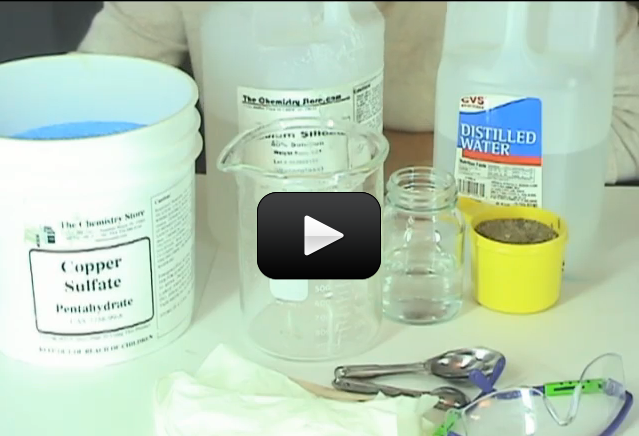This experiment is for advanced students. Water Glass is another name for Sodium Silicate (Na2SiO3), which is one of the chemicals used to grow underwater rock crystal gardens. Metal refers to the metal salt seed crystal you will use to start your crystals growing. You can use any of the following metals listed. Note however, that certain metals will give you different colors of crystals.
Your crystals begin growing the instant you toss in the seed crystals. These crystals are especially delicate and fragile – just sloshing the liquid around is enough to break the crystal spikes, so place your solution in a safe location before adding your seed crystals.
After your garden has finished growing to the height and width you want, simply pour out the sodium silicate solution and replace with fresh water (or no water at all). Due do the nature of these chemicals, keep out of reach of small children, and build your garden with adult supervision.
Here’s what you need to get:
Please login or register to read the rest of this content.


There actually aren’t any pauses in the video. I think this is a problem with your computer or internet connection. Try restarting your computer and ensure you have a good internet connection.
Aurora the videos are sticky! I don’t miss anything you say, but it is frustrating having unpredictable pauses throughout the video! HELP.
also what whould happen if you just put sodium silicate and copper sulfate together without the water
and how do i find distilled water we live in canada could i make it ?
isnt copper sulfate blue stone ?
we use blue stone in our dugout
isnt copper sulfate blue stone ?
we use blue stone in our dugout.
It is important to use the exact ingredients and to follow the directions exactly as they are provided.
do i have to use sand???
oops HAHAHAHAHAHAHAHAHAHA!!!!!!!!!!!!!!!!!!!!!!!!! I think I was a little bit redundant there!
Does this experiment take a pot that we won’t use again, because my mom doesn’t have an old pot that we won’t use again :s
Does this experiment take a pan that we won’t use again, because my mom doesn’t have an old pot that we won’t use again :s
Excellent question! What kind of experiment can you do to answer that question?
It depends on how saturated your solution is. The fastest mine ever grew was 8-12 hours.
One more quick question…how would salt affect the crystal growth?
Hi Aurora,
I just have a quick question. How long does it take for these to grow full size? Thanks 🙂
Okay, thank you.
For this experiment, you can use the chunks. Just put a piece in at the bottom as a seed crystal and watch it grow! If you need it smaller, then you’ll need a mortar and pestle (don’t use one that you’ll use for food) that is just for chemistry.
Hie Aurora. I bought Cupric Sulfate from the website you suggested, but they came in huge chunks. How do I get them small enough to use?
Thanks,
Jacquine Feight
The crystals in this experiment are made from metal salts that are put in a solution of sodium silicate (and water). The way that the metal salts react with the sodium silicate is where the tall columns come from – it’s the way that the precipitant comes out of the solution. If you have too many salts in the solution, the whole thing will turn cloudy because the precipitate is forming throughout the entire solution. That’s why you only add a couple so that you can control the growth of the precipitate.
The particles that form make the crystals arrange into particular patterns. The shape that a crystal forms when its growing depends upon what it’s made out of and what the environment is like when it’s forming. For example, when you’re growing a sugar crystal (rock candy), it will have the same shape every time you make it. However if you heat the solution while the crystal forms, you can get the same crystals to form exceptionally large. Carbon will form either graphite or diamond crystals, depending on the temperature and pressure that they form at.
why do the crystals grow up, not out?
Yes those chemicals react differently in the sodium silicate solution, but they are about the same in terms of “growing rates” for the crystals. 🙂
Hi Aurora,
Do the different chemicals, (calcium chloride, manganese chloride, copper sulfate…), have different growing rates and/or different outcomes? Thanks!
Juliette (12)
Oops – sorry about that! It’s fixed now – the manganese (II) chloride makes a purple rock.
You listed Manganese Chloride twice, once as purple, once as pink. Are there different kinds?
Thank you. I guess I missed a whole section!
Julie
Also part of Charcoal Crystals.
And ammonia?
Yes, for growing crystals in this experiment Charcoal Crystals.
Do we need the laundry bluing on the supplies list? I don’t see where it is used. Thank you.
Julie
Great question. (And the comment sections are mostly questions, anyway.)
Wear gloves if you have them or stick your hands inside plastic baggies before you start. Dump out the liquid (sodium silicate) down the drain with plenty of water, and place the crystals themselves in a paper towel and throw in the trash. (Don’t put the crystals down the drain.) Wash your hands thoroughly with soap and water after handling the sodium silicate if you didn’t wear gloves – it can leave a “second skin” feeling on your hands if you’re not wearing gloves and causes some people to break out in a mild rash.
This is a question not a comment. I am wondering how one would safety dispose of the crystal garden when done with it.